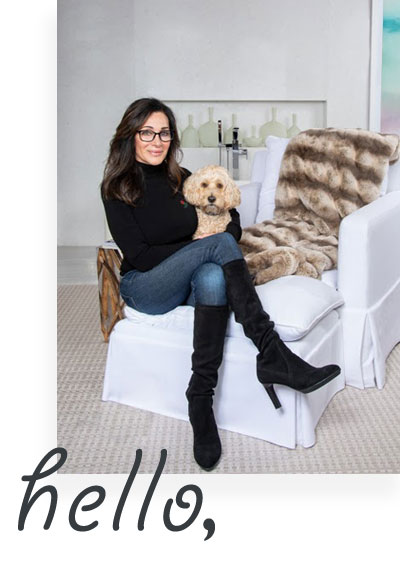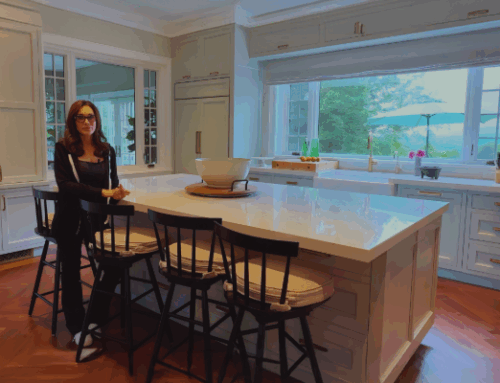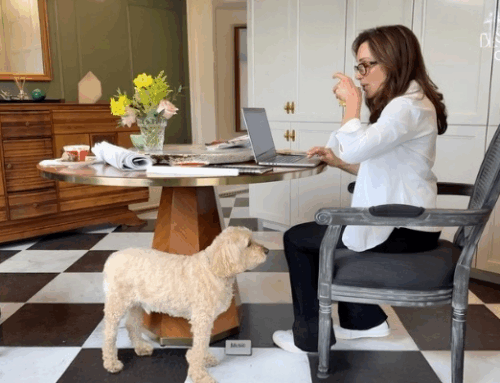Millions of children are homeschooling. And unless parents have unlimited funds, thinking “out of the box” when it comes to creating a home schooling environment for their child is a must. It’s not only about finding a desk and chair, “self regulation” is also key for a homeschool space. The term self regulate refers to a person’s ability to adjust and control their energy level, emotions, behavior and attention. In other words, if our kids are focused, anchored and happy learning from home, then we parents can focus on our work as well.
NBC Appearance: “How to Create A Sensory Virtual Learning Space at Home.”
All of us need to self regulate or we would be in a constant state of agitation, even if we don’t have sensory issues. It can be more difficult for children with sensory processing challenges (1 in 20 children in the western world) to self regulate. Personally, I believe that figure is conservative because children in the spectrum of autism and those with ADHD often have sensory challenges too.
So here’s a few ways to create sensory home “classrooms” for your children that won’t break the bank. Many of the ideas don’t cost a penny. I had a feeling you might like that! I’m a big recycler. I don’t like waste. It hurts and harms all living beings, human and non and our planet. So be prudent and frugal in your choices. As an ethical & wellness designer focused on non toxic and sensory spaces, make sure that your choices are humane and healthy. Keep toxins and bad energy away! Here ‘ya go! “Create A Virtual Learning Classroom At Home:”
Homeschool Tip #1: Make the Most of Empty Spaces & Nooks.
Most of us have areas in our home, no matter how small, that can fit a chair and some sort of desk. Look around for unused spaces like;
- The entrance to your home or apartment. That could be a great small area for study. Even a four foot wide space can be ideal for furniture.
- A bathroom is quiet and typically small. It’s a hidden study area.
- If your child is of age and you have a yard, that works with a small mobile table and a regular umbrella. Think Mary Poppins.
- A laundry room can also be set up as a quiet study space.
- A closet or office as we say (how cute right?) can be transformed into a study area. Move out the clothes. Don’t get hung up on how your home looks during this time. It won’t be magazine ready folks. But it will be “real life ready.” That’s what counts.
- Underneath a kitchen table or desk can work as a great environment for a child who needs isolation. Throw a sheet or tablecloth over it. This can work well for a child with sensory challenges. This table is handcrafted with reclaimed wood!
- A dead corner of a room can also be ideal. Look around. You do have many corners that you don’t use! Yes you do!! Your child might do great in a corner with a chair, a hamper for a table and his/her tablet on top of it.
Virtual Learning Classroom Tip #2: Be on The Move.
Learning areas should be mobile and not set in stone. Research has proven that moving around and working in different locations throughout the day helps many of us absorb information better. Consider;
- A small desk on wheels. I have one that I use outdoors on the side of my home. It’s tiny, cheap and works perfectly.
- Stand up desks are great. Everyone should have one or have a stand up desk topper to add to your existing desk or table.
- Seats and cushions that allow the body to move, swivel, wiggle etc. My personal favorites are wiggle wobble cushions, vibrating cushions, bouncy seats, swivel chairs, gaming floor seats, or seat cushions. I love this floor cushion for kids especially because it’s safe & healthy. Both the outer canvas material AND the filling are made with OEKO-TEX certified materials. This means that they meet a standard that tests whether or not a material contains toxic chemicals. This product has been deemed SAFE for you kiddos!
- Since bean bags are so easy to move around, your child can take their bean bag with them to any room of your home. This chair is a way to keep them comfy & focused at the same time! Plop this in their “study zone” with some noise blocking earphones & they’ll be set. You have to keep the energy up. If you don’t move, you get lazy. By the way, try to stand up every hour and jump, dance, wiggle or meditate. No ones looking.
E Learning Tools Tip #3: Purpose, Intent, Schedule & Routine
Think about an area for exploration & play, focus and a space for calming & reflection. These areas are a must for young children and especially those with any kind of processing and/or sensory issue such as Autism and/or ADHD..
- Exploration & play can be messy. The bathtub or outside is ideal if you have a yard. If not, the tub can be the art room. Let all the mess happen there. Or if in the yard, this fun play time mat is handmade from 100%, hypoallergenic cotton. It’s a great way to stimulate your child’s imagination & creativity while you’re hard at work. These wooden scoops, tongs and cups and pots simulate fine motor skills and sensory play. Toys like these are great at keeping your child’ attention for long periods of time AND they’re made from wood and non toxic materials.
- Focus. This environment differs for each child since we all have our own thumbprint, don’t we? Don’t forget that. You can’t fit a square peg in a round hole. One child might focus well in the midst of noise and chaos while another needs complete silence. Go with it and respect their sensory needs!
- Calm and reflection. This is as important as focus and play. If you have room, an inexpensive canvas teepee with a pillow or two inside it is ideal for 10 minutes of meditation. This beautiful & playful teepee is made of unbleached, cotton canvas without any toxic chemical treatment or flame retardants! It even comes equipped with a color changing LED light at the top which helps to create a fun atmosphere inside. Children should learn to meditate when they are young. It’s a valuable skill that will carry them throughout their entire life.
- Schedule and routine are very important for all of us. We are all creatures of habit. If you can, lunch should be eaten in a separate area from work. It is a wonderful mental break and will keep keyboards free from crumbs. Enjoy this period of time with your children. Did you ever imagine that you would be able to prepare lunch together as a family on a Wednesday? Relish it, embrace it. Cause it won’t last forever.
Homeschooling Tip #4: Have Your Kids Personalize Their Study Area.
Get your children involved in the set up of their study spaces no matter how young. Have them take ownership and make the space their own regarding comfort and function. This is one of the perks of home study. They can personalize their spaces. Make sure they are not surrounded by products with chemicals especially if you have a child with ADHD, sensory and/or processing issues.
- Have them make and decorate their own room divider with an old tablecloth with markers, glue, stickers and so on. Perhaps they can write their weekly schedule on an old sheet that can function as a divider too.
- Have them decide on a system for timing. Most of us are visual, tactile learners and seeing how much time we spend on things keeps us on task. This one is a must. Great for kids with processing issues. It “shows” time. One of our favorites, Mark L. Miller.
- Create break cards that can taped up somewhere. The cards can display what fun things they will do during their breaks such as dancing or having a snack together. We humans yearn for routine and schedules. We like to know what we are going to do in an hour, three hours etc. Break cards are a positive way to instill self regulation and calmness by knowing what’s ahead.
- Select essential oils together for the study areas. Mint for stimulation and lavender to calm.
- This personalized wall calendar works as a family ‘command center’ or personal organization station. Each calendar comes with: 1 Set of standoffs in the color of your choice, 1 Wet erase marker in black & Easy to follow hanging instructions!
- Have your children plant a few herbs to place and nurture near their study area. Biophilia (designing with nature), is essential for positivity. Looking at nature releases endorphins (the happy hormone).
We all want to be happy, healthy and strong. Your child’s homeschool environment must embrace that mantra. Make sure you choose decor and furniture that is non animal based (vegan), non toxic and positive.
Join our Facebook Community Design for a Non Toxic & Cruelty Free Home.
Check out our non-toxic and cruelty-free Amazon shop.
In case you missed it 🌸
Have you taken our newest beginner course?!
Learn more about the Online Nursery & Kids Room Design Course.
Need help creating a safe & healthy home for you & your family?
BOOK US for a 20-minute call!
Need even more family-friendly home design tips?
Meghan Markle and her choice of nursery paint.
Read more about pesticide-free Gardening Know How
How a good desk chair will improve back pain.
How to protect our marine life ocean plastic.
Best Materials for a Kitchen Backsplash Remodel.
What are volatile organic compounds (VOCs)?
How time in nature can improve our mental health and sharpen our cognition?
Why should I be concerned about lead poisoning?
31 Kitchen Color Ideas to Elevate Your Cabinetry Without a Full Remodel.
Just a heads up, this article may contain links to affiliate sites, products or services. If you purchase something through one of those links, you won’t pay a penny more! The affiliate simply provides us with a small commission which helps us fund our operations, promoting healthy & compassionate interior decorating.
Share this with friends!

I’m Deborah! My mission is to show others by demonstration, that no living being, human & non, be sacrificed for beautiful, non toxic, healthy & durable furniture & decor. More about me.
















